Remember Milliways, the Restaurant at the End of the Universe, from The Hitchiker’s Guide to the Galaxy?
Remember how Milliways will eventually be built on the remains of Frogstar B, which also happens to be the home of the Total Perspective Vortex, a machine designed to destroy one’s soul by demonstrating one’s own size and importance in painful relation to the vast infinity of creation?
I have long felt that Southern California needed a Milliways, if not also a Total Perspective Vortex (but that’s a topic for another guest post). Imagine my delight, therefore, at discovering The Café at the End of the Universe on our most recent trip to LA!
No joke: thanks to the recent extensive renovation of one of LA’s most iconic locations and the culinary intervention of cheflebrity Wolfgang Puck, you too can now enjoy a honey-infused organic pizza–or a more pedestrian yet just as mind-blowingly expensive Coke and bag of chips–at the end of the universe. (Happily, unlike Milliways, hot tea is to be found in abundance.)
The end of the Los Angeles universe turns out to be located high on the southern slope of Mt. Hollywood, at the tippy-tip of Griffith Park, overlooking the LA basin. You Angelenos know what I’m talking about: the fabulous Griffith Observatory, with its stately 12-inch Zeiss roof telescope and 1930s charm.
Such a gorgeous setting, and such a wonderful reminder of the undergrad and grad years spent in Southern California. I can’t think of a place that better symbolizes some of the tough tradeoffs we’ve made in moving from The Golden State to good ol’ Florida: although LA’s horrendous light pollution, coupled with its smog, drowns out most of the night sky, the balmy 60-degree summer evening weather nevertheless makes it possible to sit out under said night sky, seeking the stars, for hours and hours on end. Even our former cat Iggy (Iggy the Timid, the cat who dreaded all interaction with the natural world) used to love sitting out on the balcony in LA as we trained the telescope on distant constellations and star clusters. Good ol’ Ziggy Stardust.
Griffith was one of our favorite LA haunts back in grad school days, and since we left for Florida just a few months before the entire site closed for extensive remodeling, we had been especially eager to see the redesign. Reopened in 2006, the site now features 40,000 square feet of new space with exhibit galleries, a planetarium, an “event horizon” presentation theatre (appropriately named after one of the project’s largest donors, and probably the most famous alien of all time, Leonard “Mr. (I am not) Spock” Nimoy), an expanded terrace, a much larger gift shop (featuring tiny astronaut flight suits for the toddler set), and of course the café at the end of the universe.
[I know what you’re wondering, and the answer is no. No, I did not succumb to the urge to buy a tiny astronaut suit for Eric, even though: (1) he would have looked TOTALLY adorable in it, and (2) he will be old enough to grasp much of the trick-or-treat concept this year. I probably wouldn’t have been able to resist had he actually been on this trip to Griffith, but since he was experiencing an event horizon of the nap-ly kind back at the house, my credit card emerged from the black hole that was the gift shop relatively unscathed.]
On to the actual building redesign, which is nothing short of stunning. For starters, the new terrace space opens up better vistas of the basin and the Hollywood sign.
The addition of exhibit space underneath the ground also means that the upper terrace level is much less crowded, and the gorgeous 1930s building design can become more of a visual focal point.
And on the lower level, major new exhibits bring astronomy to life in fabulous ways. One of my favorite exhibits was a display focusing on our “cosmic neighborhood”: as one moves along the panels, one progresses from planet to solar system to galaxy to nearby galaxies, etc.
There was also a cool display of our very own galaxy. Visitors are invited to press a large button that will light up our solar system. A “YOU ARE HERE” marker on the cosmic map. So you press the button and … and wait, we are … where? Where ARE we exactly on this display board? After minutes of searching, you find the microscopically small tiny red light that has lit up, but it is SO small in comparison to the rest of the galaxy that it’s like trying to identify a specific grain of sand on the beach. (Gosh, I guess LA does actually have its own version of the Total Perspective Vortex! Maybe I’ll have to call Griffith “Frogstar B” from now on.)
(If you’re having trouble finding our little planet, click here, and then click the picture that shows up.)
The bottom and top levels of the planetarium are now joined together thematically by a very cool transit lens/site that projects the movement of the sun onto the bottom level of the terrace. By leaning over the side of the wall, on the top level of the terrace, you can get a great view of the sun’s shadow as it cuts across the lens and hits the brass marker.
On the top floor of the observatory building, the famous Foucault Pendulum is still proudly on display–although OSHA has apparently declared that because of the hazards posed by the 240-lb. brass ball oscillating on a 40-ft. cable, observatory workers are no longer allowed to climb down into the pit to set the knocked-over pegs upright. So the pegs rest on a platform that can be lifted up mechanically. Nevertheless, the pendulum is a glorious sight, and a most ingenious demonstration of the rotation of the earth.
The Foucault Pendulum bisects the top (“ground”) floor into two main wings: the Hall of the Eye and the Hall of the Sky. The Hall of the Eye “focuses on how people have observed the sky and the often profound impact those observations have had on people and society.” Profound observations, certainly, but the strange and eerie physicality of the exhibits is still what strikes me the most in this hall: I shiver in the carnavalesque darkness of the large “camera obscura” room, am cowed by the sheer bulk of the monstrously large Tesla Coil display that pops and hisses insistently as it has done lo these many decades. (I wonder what its bright and shiny new neighbors think of all this fuss.)
The Hall of the Sky “establishes each person’s connection to the primary objects in our sky: the Moon and the Sun” — primarily via active solar telescopes, but also through exhibits. The one entitled “Our Sun Is a Star” shows both the age and relative size of our sun compared to others and was quite pretty in an eye-poppingly bright kind of way, but my favorite was”The Elements” — an eight-foot tall display box in which each element has its own large see-through plastic cube containing an actual sample of the element.
It reminded me of the critique my college art teacher gave of my painstakingly-created charcoal still life of a lemon: “This is the most melodramatic lemon I have ever seen.” If you’re looking for chemistry that’s larger than life, this is the place.
Absolutely a wonderful visit. Can’t wait to get back.
Predictably, the cultural weight (and touristic force) of the observatory has not been lost on the folks who run it; they have moved the memorial bust of James Dean to a more propitious spot so that star-seekers can now snap Dean and the Hollywood sign in the same picture frame. Nor has it been lost on the LA County Visitor’s Bureau. One of the very first signs to greet us, as we arrived inside the terminal at LAX, was a huge ad board urging us to “Do Some Star Gazing” and showing off the magnificent terrace vista view of Los Angeles by night.
Of course, at an observatory as city-locked as Griffith is, city lights are about all one can see well at night, except for the moon and sometimes the major planets. But visitors who come to Griffith at night are not coming, for the most part, to see the planets or the moon, or even the café at the end of the universe–they’re coming for the City of Los Angeles itself, laid bare by its night lights.
Back in the day, when we were frequenting the observatory of a Saturday night, an equally compelling raison d’être for the masses to see Griffith at night was the wildly popular Laserium show set to Pink Floyd tunes. (Never saw it myself.) So I was somewhat surprised to find out that despite–or perhaps because of?–the vast crowds that Laserium used to draw to their weekend shows at Griffith, they got the boot with the new remodel. Displaced, we presume, in favor of more scientifically-informed views of the dark side of the moon. But diehard rockers aren’t entirely left out in the cold. The Laserium show, an “LA sci fi landmark,” has apparently been picked up by other venues, like … Cal State University Northridge, located mere blocks away from the Kolstad family manse.
To which we returned after a splendid day of star-gazing, Griffith-style. For a complete gallery of pictures, see below.
P.S. Looking for a job in this tough economy? Look no further. The café has apparently escaped the withering effects of the recession, perhaps due to its unique position on the time-space continuum; the observatory’s official website directs all those “interested in a position at the Cafe at the End of the Universe (operated by Wolfgang Puck)” to fax a resumé on over.

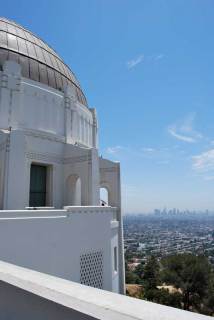
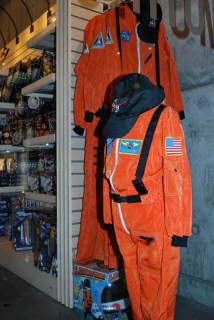
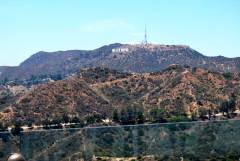
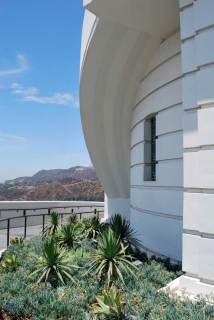
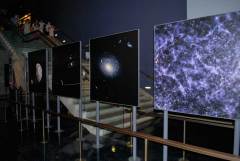
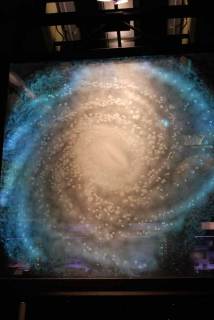
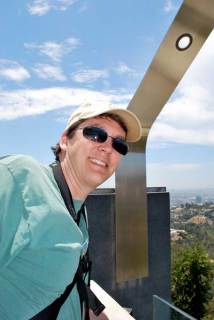
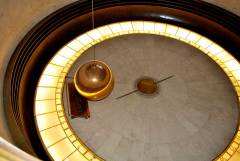
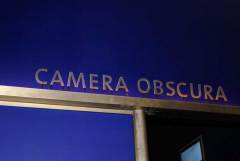
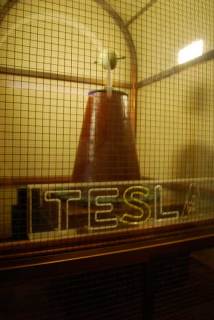
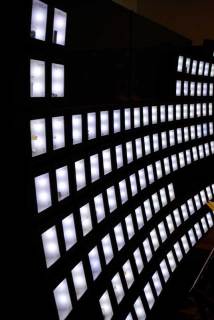
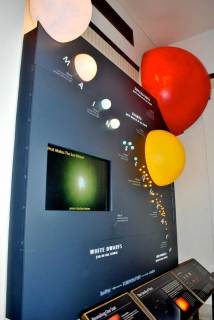






























Wonderful review! Worth the wait! Next time you’re in LA, I really want you two to take ME. This sounds like a most memorable visit. (Not sure I could resist the toddler-sized astronaut suit!)
— Meme